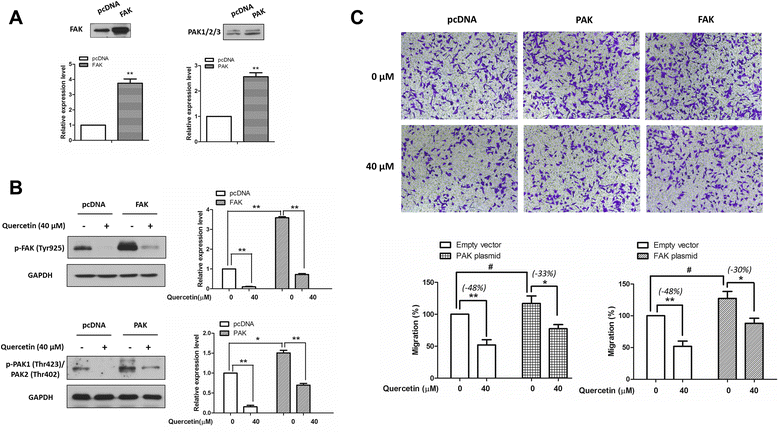Quercetin inhibits HGF/c-Met signaling and HGF-stimulated melanoma cell migration and invasion
- PMID: 25971889
- PMCID: PMC4435529
- DOI: 10.1186/s12943-015-0367-4
Quercetin inhibits HGF/c-Met signaling and HGF-stimulated melanoma cell migration and invasion
Abstract
Background: Melanoma is notorious for its propensity to metastasize, which makes treatment extremely difficult. Receptor tyrosine kinase c-Met is activated in human melanoma and is involved in melanoma progression and metastasis. Hepatocyte growth factor (HGF)-mediated activation of c-Met signaling has been suggested as a therapeutic target for melanoma metastasis. Quercetin is a dietary flavonoid that exerts anti-metastatic effect in various types of cancer including melanoma. In a previous report, we demonstrated that quercetin inhibited melanoma cell migration and invasion in vitro, and prevented melanoma cell lung metastasis in vivo. In this study, we sought to determine the involvement of HGF/c-Met signaling in the anti-metastatic action of quercetin in melanoma.
Methods: Transwell chamber assay was conducted to determine the cell migratory and invasive abilities. Western blotting was performed to determine the expression levels and activities of c-Met and its downstream molecules. And immunoblotting was performed in BS(3) cross-linked cells to examine the homo-dimerization of c-Met. Quantitative real-time PCR analysis was carried out to evaluate the mRNA expression level of HGF. Transient transfection was used to overexpress PAK or FAK in cell models. Student's t-test was used in analyzing differences between two groups.
Results: Quercetin dose-dependently suppressed HGF-stimulated melanoma cell migration and invasion. Further study indicated that quercetin inhibited c-Met phosphorylation, reduced c-Met homo-dimerization and decreased c-Met protein expression. The effect of quercetin on c-Met expression was associated with a reduced expression of fatty acid synthase. In addition, quercetin suppressed the phosphorylation of c-Met downstream molecules including Gab1 (GRB2-associated-binding protein 1), FAK (Focal Adhesion Kinase) and PAK (p21-activated kinases). More importantly, overexpression of FAK or PAK significantly reduced the inhibitory effect of quercetin on the migration of the melanoma cells.
Conclusions: Our findings suggest that suppression of the HGF/c-Met signaling pathway contributes to the anti-metastatic action of quercetin in melanoma.
Figures





Similar articles
-
Involvement of PI3K/Akt signaling pathway in hepatocyte growth factor-induced migration of uveal melanoma cells.Invest Ophthalmol Vis Sci. 2008 Feb;49(2):497-504. doi: 10.1167/iovs.07-0975. Invest Ophthalmol Vis Sci. 2008. PMID: 18234991
-
Inhibitory action of naphtho[1,2-b]furan-4,5-dione on hepatocyte growth factor-induced migration and invasion of MDA-MB-231 cells: mechanisms of action.Clin Exp Pharmacol Physiol. 2014 Sep;41(9):716-26. doi: 10.1111/1440-1681.12272. Clin Exp Pharmacol Physiol. 2014. PMID: 24909202
-
Boswellia frereana suppresses HGF-mediated breast cancer cell invasion and migration through inhibition of c-Met signalling.J Transl Med. 2018 Oct 12;16(1):281. doi: 10.1186/s12967-018-1660-y. J Transl Med. 2018. PMID: 30314527 Free PMC article.
-
Hepatocyte growth factor/MET in cancer progression and biomarker discovery.Cancer Sci. 2017 Mar;108(3):296-307. doi: 10.1111/cas.13156. Cancer Sci. 2017. PMID: 28064454 Free PMC article. Review.
-
Role of the HGF/c-MET tyrosine kinase inhibitors in metastasic melanoma.Mol Cancer. 2018 Feb 19;17(1):26. doi: 10.1186/s12943-018-0795-z. Mol Cancer. 2018. PMID: 29455657 Free PMC article. Review.
Cited by
-
Phytochemical Constituents and Derivatives of Cannabis sativa; Bridging the Gap in Melanoma Treatment.Int J Mol Sci. 2023 Jan 3;24(1):859. doi: 10.3390/ijms24010859. Int J Mol Sci. 2023. PMID: 36614303 Free PMC article. Review.
-
The potential anti-cancer effects of quercetin on blood, prostate and lung cancers: An update.Front Immunol. 2023 Feb 28;14:1077531. doi: 10.3389/fimmu.2023.1077531. eCollection 2023. Front Immunol. 2023. PMID: 36926328 Free PMC article. Review.
-
The Preventive Effects of Quercetin on Preterm Birth Based on Network Pharmacology and Bioinformatics.Reprod Sci. 2022 Jan;29(1):193-202. doi: 10.1007/s43032-021-00674-4. Epub 2021 Jul 6. Reprod Sci. 2022. PMID: 34231170
-
Quercetin affects apoptosis and autophagy in pediatric acute myeloid leukaemia cells by inhibiting PI3K/AKT signaling pathway activation through regulation of miR-224-3p/PTEN axis.BMC Cancer. 2025 Feb 21;25(1):318. doi: 10.1186/s12885-025-13709-9. BMC Cancer. 2025. PMID: 39984900 Free PMC article.
-
Targets and Effects of Common Biocompounds of Hibiscus sabdariffa (Delphinidin-3-Sambubiosid, Quercetin, and Hibiscus Acid) in Different Pathways of Human Cells According to a Bioinformatic Assay.Nutrients. 2024 Feb 19;16(4):566. doi: 10.3390/nu16040566. Nutrients. 2024. PMID: 38398890 Free PMC article.
References
-
- Serrone L, Zeuli M, Sega FM, Cognetti F. Dacarbazine-based chemotherapy for metastatic melanoma: thirty-year experience overview. J Exp Clin Cancer Res. 2000;19:21–34. - PubMed
-
- Atkins MB, Lotze MT, Dutcher JP, Fisher RI, Weiss G, Margolin K, et al. High-dose recombinant interleukin 2 therapy for patients with metastatic melanoma: analysis of 270 patients treated between 1985 and 1993. J Clin Oncol. 1999;17:2105–2116. - PubMed
Publication types
MeSH terms
Substances
LinkOut - more resources
Full Text Sources
Other Literature Sources
Medical
Molecular Biology Databases
Research Materials
Miscellaneous

